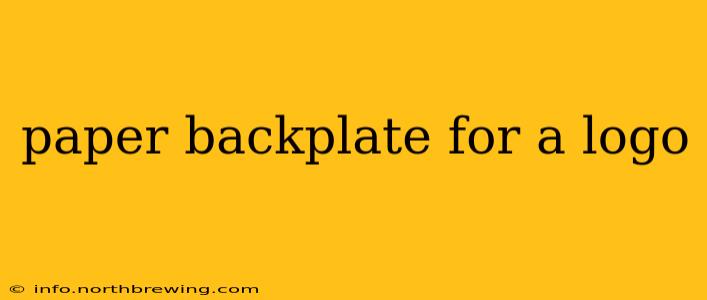Creating a striking logo is only half the battle. How you present that logo is equally important, especially in professional settings. A high-quality paper backplate can elevate your brand's visual appeal and leave a lasting impression. This guide delves into everything you need to know about designing and printing the perfect paper backplate for your logo.
What is a Paper Backplate for a Logo?
A paper backplate is a piece of sturdy paper or cardstock used as a background for a logo. It acts as a sophisticated backdrop, enhancing the logo's visibility and adding a touch of professionalism. This is frequently seen in branding materials, presentations, merchandise displays, and even as part of packaging design. The right paper backplate can communicate your brand's personality and values instantly.
Why Use a Paper Backplate for Your Logo?
Several compelling reasons exist for incorporating paper backplates into your branding strategy:
- Enhanced Logo Visibility: A contrasting color or textured backplate can make your logo pop, ensuring it's the focal point.
- Professionalism: A well-designed backplate lends an air of sophistication and credibility to your brand.
- Brand Consistency: Using a consistent backplate across different materials reinforces your brand identity.
- Versatility: Paper backplates can be used in numerous applications, from brochures and packaging to displays and presentations.
- Cost-Effective: Compared to other methods of logo presentation, paper backplates are a relatively inexpensive option.
What Paper Stock Should I Use?
The choice of paper stock significantly impacts the final look and feel of your backplate. Consider these options:
- Cardstock: A popular choice for its thickness and rigidity, providing a sturdy and professional finish. Various weights are available, offering different levels of durability.
- Specialty Paper: Explore options like textured papers, metallic papers, or even recycled paper to align with your brand's aesthetic.
- Coated Paper: Coated paper offers a smoother surface, leading to vibrant color reproduction and a more polished appearance. This is ideal for intricate logo designs.
Designing Your Paper Backplate: Key Considerations
- Color Scheme: Choose colors that complement your logo and brand identity. Consider the color psychology behind your choices. A striking contrast often works best.
- Logo Placement: Ensure your logo is centrally positioned and appropriately sized. Leave enough space around the logo for readability.
- Font (if applicable): If you're including text, select a font that aligns with your brand's personality and is easily readable.
- Graphics (if applicable): Subtle background graphics or patterns can enhance the design, but avoid anything that distracts from the logo.
How to Print Your Paper Backplate: A Quick Guide
You have several options for printing your paper backplates:
- Professional Printing Services: Offers high-quality results, especially for large print runs or intricate designs. They can advise on the best paper stock and printing method.
- Home Printer: Suitable for small-scale projects or prototyping. Ensure your printer can handle the chosen paper stock and offers sufficient print quality.
What are the different sizes of paper backplates?
The size of your paper backplate will depend entirely on its intended use. Common sizes range from small business card-sized backplates to larger formats for displays or presentations. There's no standard size; you should determine the appropriate size based on your needs.
How much does it cost to print paper backplates?
The cost varies considerably based on several factors: the quantity printed, the paper stock used, the printing method, and the complexity of the design. Professional printing services typically provide quotes based on your specific requirements. Printing at home will generally be significantly cheaper, but the quality may not be as high.
What are the benefits of using a paper backplate over other options?
Paper backplates offer several advantages over alternatives, including affordability, ease of design and printing, and versatility in application. They're easily customizable, allowing for a unique presentation tailored to your brand. Furthermore, they're sustainable if you opt for recycled paper stock.
Conclusion
A well-designed paper backplate can significantly enhance your brand's visual identity. By carefully considering the paper stock, design elements, and printing method, you can create a professional and impactful presentation that effectively showcases your logo and strengthens your brand message. Remember to prioritize clarity, consistency, and a design that aligns perfectly with your overall brand aesthetic.
